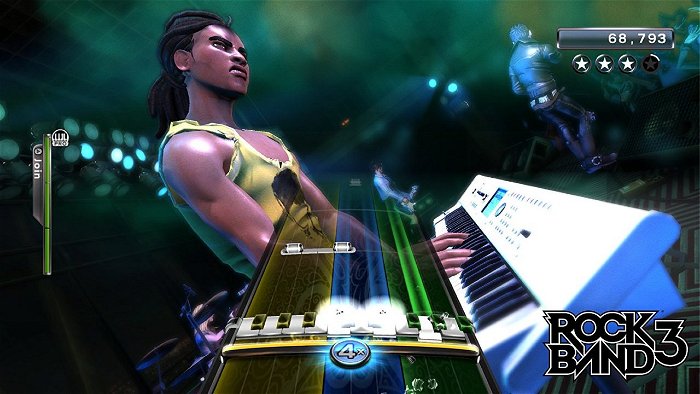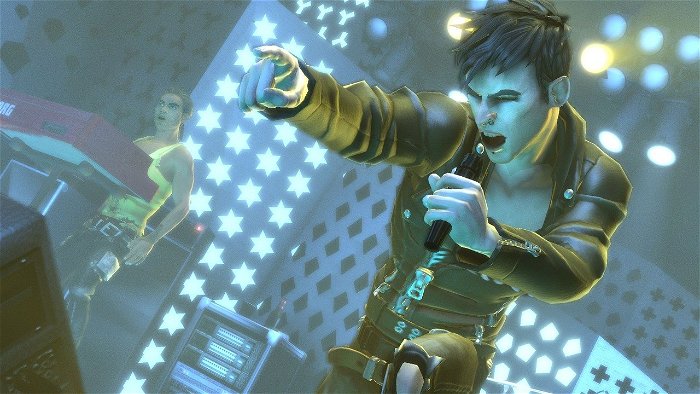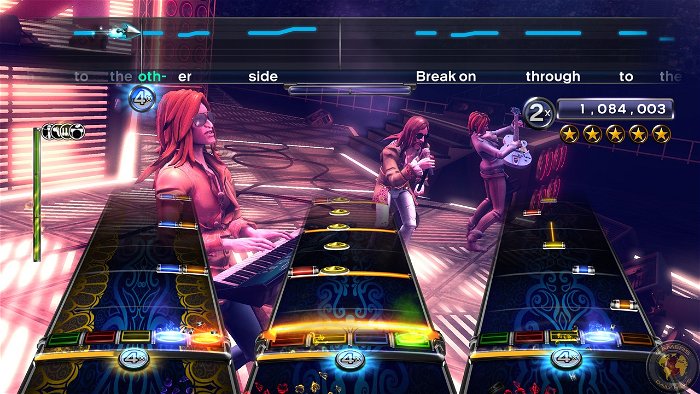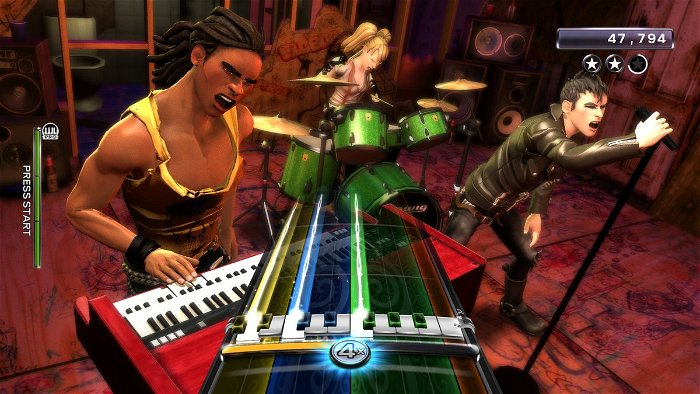Deep within the bowels of the C&G dungeons, it is common knowledge that I am a slave to the rhythm games. Having first spent obscene amounts of money in Asian arcades on Konami’s Beatmania, Guitar Freaks, Percussion Freaks and Keyboardmania, it was only natural that after all that over exposure to J—Pop tracks, the debut of Guitar Hero was the equivalent of a traveler lost in the Sahara finally coming upon an oasis.
Since then it’s been a natural, expensive progression from Guitar Hero to Rock Band and the advent of new peripherals and weekly additions of new songs. It got to the point where Rock Band 2 was such a strong, comprehensive package that I really began to wonder what direction Harmonix could take the rhythm genre to in order to keep things fresh.
I got my answer, and it is nearly as expensive as it is exhilarating.
Penultimate Progression
The best way to imagine the design ethos of Rock Band 3 is to use the phrase, “Shut the hell up.”
There have been criticisms both constructive and damning of rhythm games since their debut, and Harmonix has addressed all of them in a way that makes it clear they want their detractors to just Shut the Hell Up. Is it too repetitive and structured? Well, they’ve mixed up gameplay modes, so Shut the Hell Up. It’s not “party friendly?” Well, they’ve redesigned party play entirely, so Shut the Hell Up. There are no new instruments? Well, they’ve got a keyboard now, so Shut the Hell Up. Why don’t you go and learn to play a real instrument instead? Now you can do just with Rock Band 3, so Shut the Hell Up.

Rock Band 3 is far more than Rock Band 2. A lot of that has to do with the fact that they had more than just one year to work on it, but the result is that this is not a handful of subtle tweaks, rather a drastic overhaul of both the game and some of the basic principles of the rhythm genre.
The first and most obvious new addition is that of the keyboard. Konami had already established a precedent for simultaneous co—op play by linking Guitar Freaks, Percussion Freaks and Keyboardmania arcade cabinets together, but Harmonix has refined this with the Rock Band series, and presented the definite experience in Rock Band 3. The keyboard, out of the box, is a MIDI compatible instrument that can be used for actual music play, though it is confined to only two octaves, or 25 keys.
At the recent E3, I managed to get some hands—on time with the keyboard. There are two ways to play it, the “traditional” Rock Band way in which the standard playfield appears on screen and the user is confined to five keys from the entire keyboard on which to play. In this normal mode, the keyboard is going to quickly become a favourite of players for sheer ease of use. However, the real challenge comes when users select “Pro Mode” a new mode introduced for all instruments. In Pro Mode, the playfield changes to a representation of the keyboard and icons descend down the “note highway” indicating which keys to press. Pro Mode is a completely different mode of play; it’s not the next step after Expert, instead having its own levels of Easy, Medium, Hard and Expert.
For my hands—on time I ended up playing The Power of Love by Huey Lewis and the News, on Medium Pro Mode, the earliest mode at which chords are introduced. There’s a bit of a learning curve involved, though I’d speculate the people that would have the easiest time with the mode are non—musically inclined players new to the game. Experienced musicians used to traditional musical notation and hardened veterans of rhythm games will likely find themselves fighting their established reflexes in order to adjust to this new kind of notation.
Once the adjustment period is over though, players will find themselves getting comfortable, having fun, and, if they’re ambitious enough, moving on to Pro Mode Expert where the songs are played note for note. John Drake of Harmonix made the bold claim that due to endless repetition of Queen’s Bohemian Rhapsody during demonstrations of the game in Europe, he was able to sit down at a piano in the hotel they were staying at and actually play the piano sections of the song.
Going Pro
Pro Mode itself is probably the biggest news for Rock Band 3. The long suffering criticism that many had of rhythm games—most notably from actual musicians—was that it was a waste of time to play fake music games when people could be learning to play real instruments. Pro Mode is that answer, though I’m personally starting to wonder if it won’t actually eat into the business of actual music instructors when Rock Band 3 finally hits the shelves.
Guitar, Drums and Keyboards all benefit from this new mode and it is essentially a personal music instructor for your instrument of choice. Eschewing the traditional note highway playfield that Harmonix established with the first Guitar Hero, a custom playfield for the instrument of choice appears instead, with extensive tutorials to get ambitious gamers up to speed on learning how to play their preferred instrument for real. As mentioned before Pro Mode has the traditional difficulty levels, so on Easy mode, beginners will be playing single notes, gradually ramping up in complexity until Pro Mode Expert where, whether its guitar, drums of keyboard, users are playing the song note for note.

Harmonix has even gone the extra mile of including individual tutorials for the songs themselves, so that masochistic guitarists subjecting themselves to the insane guitar solos of Ozzy Osbourne’s “Crazy Train” can sit down in depth and learn the proper hand placement on the new guitar peripherals and get the notes down.
Pro Mode comes with new instruments and new accessories, the most notable of which is a new MIDI interface. For people that already have synth drums or keyboards with a MIDI output, this will allow those owners to plug their instrument into the interface, which then plugs into their console. In other words, you can use your real synth drum or keyboard to play Rock Band 3. For people that don’t want to upgrade to entirely new instruments but are still interested in the Pro Mode, various options are available. Drummers, for example, can simply purchase additional accessories in the form of extra high hats and cymbals that can plug into an existing Rock Band drum kit and allow them to play the drums in Pro Mode.
Harmonix has finally managed to bridge the gap between a game and a legitimate learning tool. They have taken the fun, flamboyancy and constant personal feedback of video games and combined them with actual musical instruction. The higher minded critics of rhythm games who claimed “You should just play a real guitar” as a criticism of the genre now have nothing to fall back on.
Partying With Mario
When describing the overhauled group play mechanics, John Drake of Harmonix invoked the phrase: “It’s like Rock Band meets Mario Party”.
This is in reference to the fact that Harmonix has recognized the series’ popularity in party settings and has reworked mechanics to ensure that in a spontaneous—and potentially embarrassing—social setting, things go much more smoothly. Players are no longer limited to simple Quick Play mode, as “mini—quests” can be created for the evening, ranging from touring the East Coast of America to going on the first leg of a World Tour.

The big new development is a concept Harmonix refers to as the “Overshell”, which as individual interface for each player. In previous games, one player was the agreed upon leader, but any player could still use their instrument actively. In practice this meant that when a band leader was in the middle of choosing a song, a new, excited drummer could sit down, happily whack at away at the drum pads to get a feel for them and inadvertently kick the entire group back out into the main menu during his warm up. Now with the Overshell, everyone has their own menu available for tweaking, at any time, even during the middle of a song, and it has no impact on what others are doing.
For the first time in Rock Band, Harmonix is finally taking a page from its competitor, last year’s Guitar Hero 5, and including new features such as drop—in/drop—out options for players during songs, so that people can switch in and out of instruments without having to hold up a song for everyone else. They can also now change the difficulty on songs on the fly, another feature from Guitar Hero 5. Setlist creation has also been introduced into the game, so that players can create and save their favourite songs, and even compile new setlists on the official Rock Band website to send to their consoles for play when they get home from work. Even the filtering system has been upgraded to include multiple options so that players can perform specific searches such as songs only from Rock Band 2 that are from the 80’s in the Metal genre, and are short songs.
The campaign mode of Rock Band 3 has also been given a major re—tooling. The game is still the story about your created band rising up from nothing to fame and fortune, but this time out, much more emphasis is being placed on “bonding” with your band. In addition to a new art direction, the expected new outfits and other customization options, players will now see their band in small cinematics such as getting their first van, practicing before a performance or wandering the streets. Now, no matter where players go, be it a settings menu or song selection screen, their created band is always visible in the background, not just during performances.
The lengthy traditional campaign has now also been restructured. Every instrument has a wealth of individual challenges to meet, rather than an overarching goal of simply playing all the songs repeatedly to get to a final concert. The new goal with these challenges is to help those players that wish to improve their game do so in a meaningful way, with measurable progression. When combined with all instruments, John Drake claimed that there are hundreds of these personal and band challenges available.

The Future of Rock
There’s still no release date on Rock Band 3 other than a nebulous “Holidays 2010” estimate, but the pricing on a new game with keyboard peripheral has already been confirmed at $130. That still leaves Harmonix with a few months to polish and optimize as well address concerns from some fans of the game over noticed omissions. For example, while the guitar is clearly geared up for Pro Mode, there hasn’t been much talk of the same for the Bass Guitar, which is a four—string, rather than six—stringed instrument. Eagle—eyed fans have also noticed that in “full” bands with up to seven players in demonstrations, the vocalists are no longer being scored or adding to the total band score, which leaves some worried that singers are getting the short end of the stick on this iteration.
One thing is for sure certain, however. While there may have been a slump in the sales of rhythm games last year, it’s unlikely that the genre is going to just die. New instruments and modes keep Rock Band 3 infused with enough freshness to attract its fans all over again, and efforts like Harmonix’s other title, Dance Central are poised to pull in many, many more.
Rock n’ roll will never die—it’ll just go classic.




